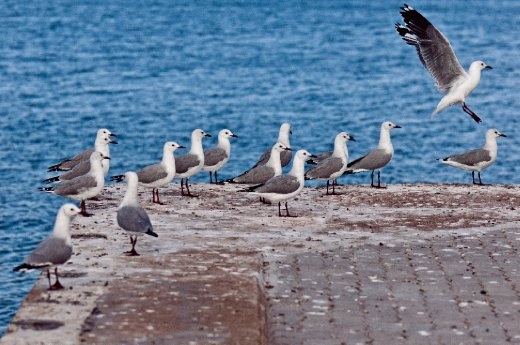We finally made it to the airport
and caught our re-booked flight to Cape Town. When we got there I was taken
aback by the amazing scenery there; the city is nestled along the slopes of
Table Mountain and bordered by the Atlantic Ocean.

As we planned our day, Guts notified
us that Table Mountain was closed due to cloudy weather. We went up to the
rooftop of an upscale apartment villa which had a great view of the city to
take some shots. Jason advised me to be sensitive to the direction of light as
this can increase contrast, shadows, textures and reflections in the picture.
High levels of contrast can fool cameras into exposing the scene incorrectly
but you can easily overcome this with exposure compensation.

We collected our tickets to Robben
Island but we found out that they were normal tourist tickets and due to
paperwork complications, we were not granted photography passes. This meant
that we would be joining tourists on a tour around the island. We had a quick
bite at the port while watching seals swim in the water underneath us then took
the ferry. Not holding any photography passes and with the amount of gear we
carried, we ran into a bit of trouble with the security guard but luckily, we
were finally authorized aboard. Throughout history, Robben Island had been
mainly used to isolate political prisoners. It was here that Nelson Mandela
spent decades imprisoned during the Apartheid regime among other political
prisoners.

As soon as we arrived at Robben
Island, Jason confiscated my digital camera and had me use his Hasselblad Xpan
Panoramic film camera instead! The first thought that crossed my mind was to
flee into the group of tourists ahead! It’s not that I don’t like film cameras;
I own a Holga CFN 120 and I love it. It’s just that I got used to shooting
digital since I find it faster, more convenient and flexible. Anyway, I only
had 10 photos remaining on his film camera, which should suffice for the prison
visit, after which I could get my camera back. He briefed me about its
functions and control buttons as we evaded the tourists. We got to the prison’s
back entrance door only to find out we couldn’t proceed without a guide. So we
spent the wasted time outside in the burning sun. The repetitive shutter
release sounds coming from Jason’s two DSLRs finally decided me to take my
first shot! I framed my shot onto the prison’s wall, chose the appropriate
aperture bearing in mind the depth of field, depressed the release button to
get a reading of the shutter speed, changed the ISO for correct exposure then
focused and took the shot with minimal hand shake – I hope. Too bad I couldn’t
see what took me 4-5 minutes to compose and freeze, but I enjoyed every second
of it.
We took some shots inside the prison
and I asked Jason for my DSLR camera back to get some shots of Mandela’s cell
after I took one with his film camera. He gave me his permission to take 3
shots only. To be honest with you, I couldn’t help it and had to take 5 shots
to finally get the one I liked... but I hated myself for doing so. Shooting
film, I quickly noticed that when shooting with digital cameras, you don’t take
enough time to think before taking the shot, since you can be taking as many
shots as you want and let the camera figure out the math or eventually like
only one photo out of dozens – a single photo you could have achieved in a single
shot with film. We left the prison joining the tourists on the tour bus around
the rest of the island and we only had 5 minutes to leave the bus and take
close photos of the quarry where the prisoners used to mine.

We concluded our day by driving around the area
close to the shore at sunset, then drove to a view point overlooking the city
to take some night shots. It was so windy that I was shivering and shaking as
badly as my tripod but we pulled it off nonetheless and headed home with a
sense of satisfaction.

